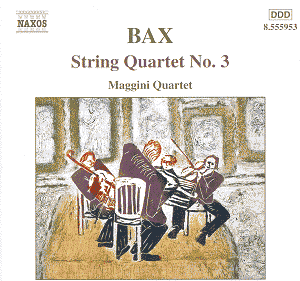The main work in this programme of Bax chamber music
is the String Quartet No. 3 in F major composed for the Griller Quartet
in 1936. It was started and finished in London while the scherzo and
trio were written at Cashla Bay, County Galway, Ireland. Bax maintained
that the first movement "was probably influenced by the coming
of spring in beautiful Kenmare". The music of this movement certainly
has a virile thrusting quality and a restlessness. This is more akin
to the more realistic evocation of nature ‘red in tooth and claw’ of
Bridge’s Enter Spring (composed in 1927) than to a dreamy idealistic
portrait. There are passages that have a raw intensity that suggest
lashing rain and screaming gales. Bax’s string writing here is as technically
impressive as it is imaginative. The second movement begins mystically,
almost hymn-like, before questing material interposes suggesting a hostile
landscape and conflict. Grotesque quivering dance rhythms against sharp
staccato stabs are heard. What tender music there is turns plaintive,
even hysterical and panicking. Had Bax’s ghosts from the 1920s returned
to haunt him? Strange unsettling music, this. In Bax’s words: "The
third movement consists of two strongly opposed elements – a rather
sinister and malicious scherzo, and a dreamy, remotely romantic trio.
This contest is finally won by the scherzo, when it converts the subject
of the trio to its own way of thinking." In the trio of this movement
Bax makes a fleeting but unmistakable reference to Elgar’s Pomp and
Circumstance March No. 4, possibly because of the Coronation mood in
London that year before the abdication of Edward VII was announced.
Bax goes on to say, "The texture of the finale is rougher and more
robust than that of the rest of the work, though there is a softening
of mood towards the abrupt and impetuous closing bars’. The music is
march-like with a cocky swagger; the mood sardonic and abrasive.
The Lyrical Interlude for string quintet is
a re-scoring, with two violas instead of cellos, of the slow movement
of a String Quintet written before the First World War and at one time
presumed lost. It has a lovely, typical Baxian long-breathed melody
and there is a magical episode that might suggest an enchanted forest
glade.
The Adagio ma non troppo ‘Cathleen-ni-Hoolihan’
from the String quartet in E major is another attractive little gem
and very Irish in its rhythms and sentiment. Bax writes a verse (slightly
misquoted) from W.B. Yeats’s early poem ‘To Ireland in the Coming Times’
at the head of the slow movement of the Quartet:
Know that I would accounted be
True brother of that company
That sang to sweeten Ireland’s wrong
Ballad and story, rann and song.
Bax’s virile String Quartet is an uneasy work played
with a nice nervous edge by the Maggini Quartet. The early works have
a charm that is immediate. Recommended to Bax enthusiasts.
Ian Lace
